Technology’s role in evolving the customer experience
As people continue to adapt to the still-developing digital world, the companies that serve (and compete for) them continue seeking new ways to add value to both their online and physical lives. Yet, as consumers grow accustomed to more integrated, personalised and on-demand services, the bar for delivering that value is raised ever higher.
To secure a spot in people’s routines, digital tools and apps must move beyond meeting expectations and seek to enable the next step for users — while requiring minimal effort and ensuring a consistent experience across all touchpoints.
When it comes to providing financial services, for example, convenience, instant access and reliable security are table stakes. The opportunity lies in asking what people want to be able to do and finding ways to make that possible . So while traditional banks work to evolve foundational products like mortgages and loans, emerging disruptors are focused on delivering value where it counts: in the customer’s pocket.
Focus on the experience
Not only are consumers used to managing nearly every aspect of their lives via their smartphones, but they’re also aware that they can choose from multiple competing tools to do so. It’s rare that one option is clearly superior (Apple Music competes with Spotify, WhatsApp with Messenger), so choices are often based on elusive criteria like a user’s familiarity with a brand or provider, or how popular an app is with their friends and family.
A key differentiator that can be easier to define and quantify is the customer experience (CX). In general, streamlined workflows, simplified language, clear choices and clean design are hallmarks of a good CX. Built into a tool that offers as much or more than its closest competitor, a positive experience can be enough to win users. In fact, a recent Gartner survey found that customer experience drives over two-thirds of customer loyalty — more than the brand and price combined.
This CX advantage is playing a key role in the rise of API banking , through which fintech challengers and non-banks are gaining millions of users by delivering innovative, user-focused services through easy-to-use frontends. So even when it comes to something as important as managing their money, consumers are choosing a positive experience and new functionality over established expertise and longevity.

Defining new challenges
Just as CX expectations have evolved, so have the challenges enterprises face when attempting to deliver better services. Identifying what users want and what the organisation is prepared to offer is just the beginning. The best intentions can be derailed by an inability to build a digital solution that delivers in a way customers will appreciate and adopt.
Two issues in particular routinely threaten projects irrespective of their scope, support or budget: the inability to adapt quickly to changing customer behaviours, and disconnected experiences and functionality across platforms.
While the first issue is not new to business, it has become a clear signal that a company’s approach is out of step with the digital economy. Consumer trends, needs and expectations evolve with every new app and are increasingly difficult to predict. If a digital tool or experience is not designed to evolve with them, it won’t.
That evolution gave rise to the second issue. While a decade ago, users accepted that the look and functionality of a website would be different on their desktop versus their mobile, the expectation today is the ability to access the same information and perform the same tasks regardless of device or location. Brands and services that fail to provide that are quickly deemed outdated.
Adding to the challenge is the range of digital touchpoints available. It’s not just desktop versus mobile — users can be on the web, in different browsers, on a mobile version of a website, in an app, on iOS or Android. For the majority of organisations, offering a consistent user experience across each one is easier said than done.
Putting technology to work
Smart, modern development is helping companies make sense of their digital challenges and create agile solutions. Rather than build an app according to a client brief, future-thinking development teams take a big-picture approach to understanding business goals and challenges, as well as user journeys and requirements, to design and build a solution that delivers value for both the customers and the company.
By leveraging modern technologies and open source , which itself continually evolves to improve performance, today’s digital solutions have a built-in ability to scale and adapt. It may be impossible to predict what the must-have feature will be next year, but implementing systems that are designed to change is the first step toward being ready to meet that demand.
Key to meeting customers where they are is providing a consistent, integrated user experience across all platforms: mobile and web, iOS and Android. Particularly when offering an important service, such as money transfer, companies need to ensure that the data, functionality and results are the same irrespective of the device customers use. Even in banking now, APIs are removing the last excuses for providing disjointed online experiences — and are actually enabling cross-platform and cross-bank functions that address real-world issues .
It’s true that the ability to take such a future-proof approach and embed it into solution development is not typical of every dev shop. But as modern enterprises wade through the remains of a 70% failure rate in digital transformations , it’s clear that typical dev won’t solve the problems that persist.
By taking an approach that instils agility and best practice at every step, and prioritises the customer experience as the path to adoption, companies can prepare for the unknown and position themselves to benefit from the inevitable disruption — even in the well-established world of banking.
Insight, imagination and expertly engineered solutions to accelerate and sustain progress.
Contact